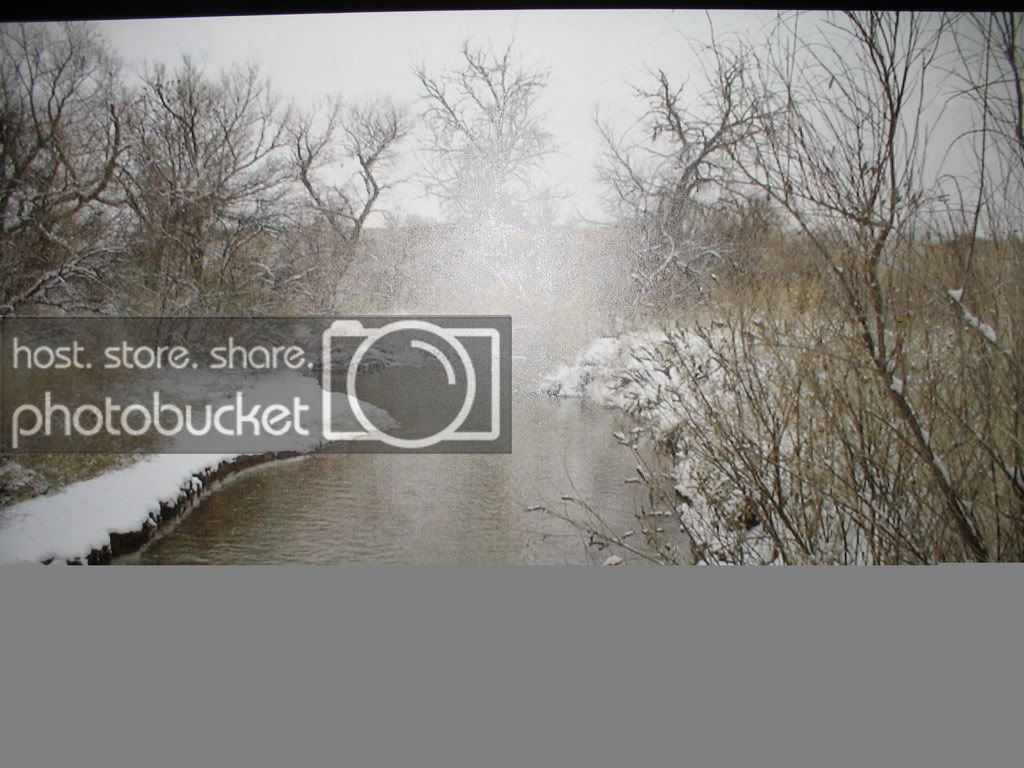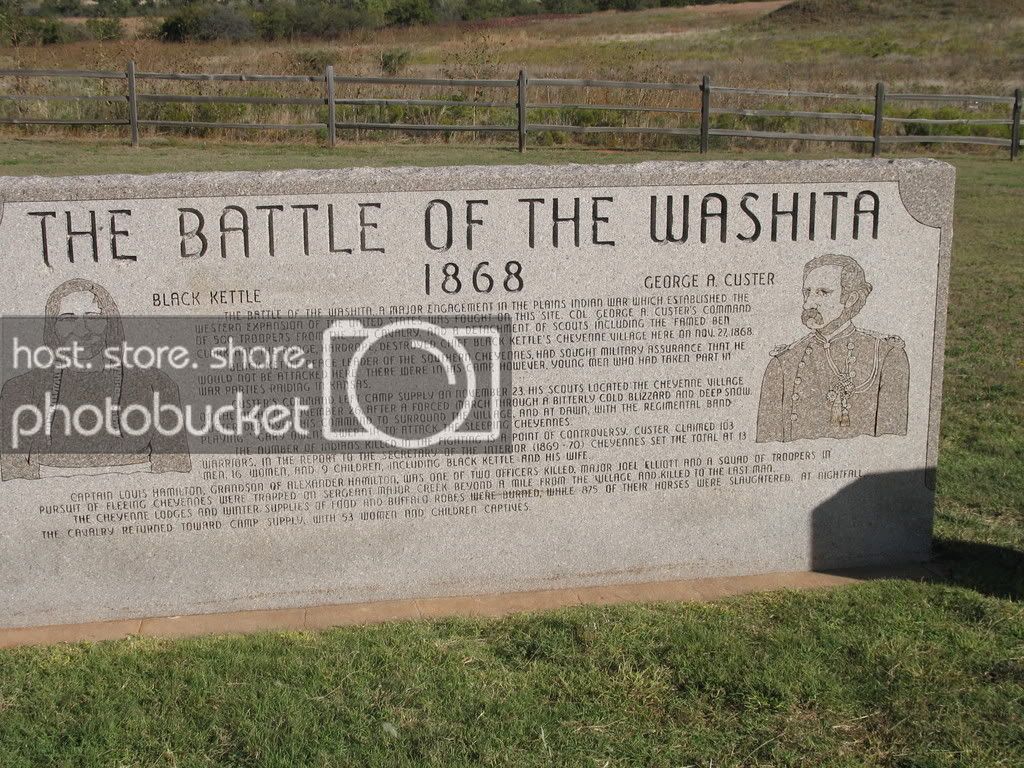( – promoted by navajo)
I’ll have a Big Mac, fries, and a medium Dr. Pepper.
Custer rides again, although he’s atop a plastic motorcycle and in a McDonald’s Happy Meal box.
My wife wants chicken McNuggets and a Coke.
The 140th Anniversary of the Washita Massacre of Nov. 27, 1868
The Cheyenne women were “transported” by an officer named Romero to the other officers once they were prisoners at Fort Cobb.
Rape.
Custer “enjoyed one” every evening in the privacy of his tent. Presumably, he stopped raping the Cheyenne women when his wife arrived.
Custer’s wife, Elizabeth (Bacon), whom he married in 1864, lived to the age of ninety-one. The couple had no children. She was devoted to his memory, wrote three books about him, and when she died in 1933 was buried beside him at West Point. Her Tenting on the Plains (1887) presents a charming picture of their stay in Texas. Custer’s headquarters building in Austin, the Blind Asylum, located on the “Little Campus” of the University of Texas, has been restored.
Jerome A. Greene. “Washita.” Chap. 8, p.169.
Ben Clack told Walter M. Camp: many of the squaws captured at Washita were used by the officers…Romero was put in charge of them and on the march Romero would send squaws around to the officers’ tents every night. [Clark] says Custer picked out a fine looking one and had her in his tent every night.”
This statement is more or less confirmed by Frederick Benteen, who in 1896 asserted that Custer selected Monahseetah/Meotzi from among the women prisoners and cohabited with her “during the winter and spring of 1868 and ’69” until his wife arrived in the summer of 1869. Although Benteen’s assertions regarding Custer are not always to be trusted, his statements nonetheless conform entirely to those of the reliable Ben Clark and thus cannot be ignored.”
I forgot to add the salad.
The fast food chain’s decision to circulate the toy in Indian Country is akin to circulating a Hitler figure in Israel, according to Laurette Pourier, executive director for the Society for the Advancement of Native Interests-Today. “It’s insensitive and disrespectful.”
The 140th Anniversary of the Washita Massacre of Nov. 27, 1868
Stan Hiog. “The Peace Chiefs Of The Cheyenne.” p. 174
Moving Behind, a Cheyenne Woman, later stated: “There was a sharp curve in the river where an old road – crossing used to be. Indian men used to go there to water their ponies. Here we saw the bodies of Black Kettle and his wife, lying under the water. The horse they had ridden lay dead beside them. We observed that they had tried to escape across the river when they were shot.”
Location of Black Kettle’s death

Warriors, eleven who died, rushed out of their lodges with inferior firepower to defend the village. Simultaneously, the overall noncombatants ran for their lives into the freezing Washita River.

(Taken with permission)
The words of Ben Clark, Custer’s chief of scouts, brought the truth out after Custer distributed propaganda about one white woman and two white boys as having been hostages in Black Kettle’s village. There were no “hostages, a Cheyenne woman committed suicide. Speculating, here is why.
She didn’t want her son mutilated by Custer or a 7th Calvary soldier; she didn’t want her vagina ripped out and put on a stick, worn, or made into a tobacco pouch. So, she killed her son and herself first.
Jerome A. Greene. Washita. Chap.7. pp. 130-131
There, as the people fell at the hands of the troopers, one woman, in a helpless rage, stood up with her baby, held it out in an outstretched arm, and with the other drew a knife and fatally stabbed the infant – erroneously believed by the soldiers to be a white child. She then plunged the blade into her own chest in suicide.
(Location of the genocide at Washita, a few yards from Black Kettle’s death)

The 7th hunted them down and murdered them. Although the orders were to “hang all warriors;” it was much more convenient to shoot them. All wounded Cheyenne were shot where they laid.
I want Ranch Dressing with that salad.
The “Night at the Museum” toys are scheduled to be distributed at McDonald’s through June 18.
No thankyou, I don’t want apple pie. Can you break a $20 bill?
You can’t? Well, Burger King is right across the street. Besides, they don’t “have a toy (that) in Indian Country is akin to circulating a Hitler figure in Israel.”
I am never, ever, ever, eating anything at McDonalds again.


WR, i am organizing an eco week at DK. would love for you to join us, perhaps posting an eco justice diary or any issue you like. 🙂
can’t find email for you at DK, or DD, and so here i am. 🙂
Eco week starts this sunday..
my email is patriotdaily@gmail.com.
thanks
I actually found this site by doing a search about the Custer character in the movie “Night at the Museum II”. I have to admit I have not watched it through, but I was caught off guard when I saw the Custer character. I think it is offensive, disgusting, and shameful to promote this “historical person” as anything but a bully, killer and rapist. I am always surprised and outraged with the acceptance and ignorance when it comes to the racist, negative one dimensional stereotyping of Native Americans. But to create an image of Custer as a quirky, but in the end likable character is really wrong. It actually hurts my heart. I can’t see our “American children” playing with a doll of Hitler, so why is Custer okay? Because the “head in the sand” ignorance many Americans have regarding Native American/American history is severely lacking! I will not sit down and shut up.
We must not allow Trump to return the “Patriotic American” narrative to public schools. Only truth will set us free.